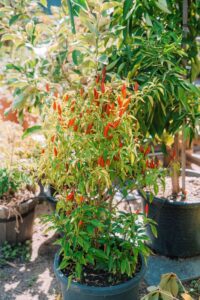Connie on your Asian veggie patch
 [Connie Cao discusses some of her favourite Asian veggies. She grows all of these plants in her backyard, many in pots, and the focus is on small urban gardens. The material is in celebration of her new (2024) book, Your Asian Veggie Patch, which you can buy online. The book includes easy-to-cook recipes as well as growing guides, so is useful even if you don’t grow your own veggies.
[Connie Cao discusses some of her favourite Asian veggies. She grows all of these plants in her backyard, many in pots, and the focus is on small urban gardens. The material is in celebration of her new (2024) book, Your Asian Veggie Patch, which you can buy online. The book includes easy-to-cook recipes as well as growing guides, so is useful even if you don’t grow your own veggies.
Connie is a local, urban permaculture gardener, homesteader, photographer and digital content creator. Go to her website. Go to her Instagram page.]
Amaranth greens
 If you’re looking for a leafy green to grow through summer, try amaranth greens, a popular Asian veggie which comes from the same genus as the amaranth flower and the grain amaranth. The plant originates from South and Central America but is commonly eaten in Southeast Asia and Southern China.
If you’re looking for a leafy green to grow through summer, try amaranth greens, a popular Asian veggie which comes from the same genus as the amaranth flower and the grain amaranth. The plant originates from South and Central America but is commonly eaten in Southeast Asia and Southern China.
While its native habitat is the tropics, it grows quickly and easily as a warm season annual here in Melbourne. I like to treat it as a ‘cut and come again’ green and it makes a great summer substitute for spinach. In my backyard, I like to direct sow my amaranth greens around early November. They germinate quickly and are fast growing plants that will give you a harvest in no time. If you let it flower and set seed, it will re-grow each year in the same spot.
Amaranth greens come in various colours, with the red varieties creating a beautiful, beetroot red soup when cooked.
Watch this video on Instagram.
Chilli
 Chilli is a prominent ingredient in many Asian cuisines. Places such as Southeast Asia, Korea and the Sichuan and Hunan provinces in China (just to name a few) love to add a bit of heat to their dishes.
Chilli is a prominent ingredient in many Asian cuisines. Places such as Southeast Asia, Korea and the Sichuan and Hunan provinces in China (just to name a few) love to add a bit of heat to their dishes.
The plants are compact and happily grow in pots, so are highly suited to small spaces.I grow all my chillies in pots so I can save my garden space for other plants. A 30-40cm wide pot is best. I like to grow my chillies with a western aspect, as they thrive in the heat. My best container grown chillies have given me more than 100 fruits per season!
Watch this video on Instagram, where I make two additional points:
- Grow chillies in full sun.
- Be patient – chillies sit green on the plant for ages and usually don’t ripen until near the end of summer.
[Editor: although most people grow chilli plants as annuals, they are actually short lived perennials if not killed by frost. If you grow your chilli plants in pots, you can move them during winter to somewhere protected from the frost, such as a greenhouse or indoors, and they will come back to life the following spring.]
Jujube
 One of my best edible garden discoveries has been jujube, a tree that seems like it grows two different fruits in one. Jujube fruits look like mini apples and can be harvested at any stage of maturity, with each stage giving you a different flavour profile. When fresh and green, jujubes are crisp and taste similar to apples. When dried, they are deep red in colour with a rich, sweet taste and chewy texture. Native to China, jujube is one of the oldest cultivated fruit trees.
One of my best edible garden discoveries has been jujube, a tree that seems like it grows two different fruits in one. Jujube fruits look like mini apples and can be harvested at any stage of maturity, with each stage giving you a different flavour profile. When fresh and green, jujubes are crisp and taste similar to apples. When dried, they are deep red in colour with a rich, sweet taste and chewy texture. Native to China, jujube is one of the oldest cultivated fruit trees.
Jujube prefers full-sun, away from strong winds. They are tough plants that will tolerate a wide range of soils, and they have a deep taproot making them drought tolerant once established. In my backyard, I like to grow jujube in a pot. This is because they can grow quite tall and send out root suckers around the garden. I grow the ‘Li’ variety, which is delicious when eaten fresh.
Watch this video on Instagram, where I make the additional point that the seeds are almost unnoticeable so you can eat the whole thing.
 Shiso
Shiso
A popular herb in Japanese cooking, shiso has soft, feathery leaves and a delicate flavour with a minty, citrusy kick. Shiso is commonly used as a garnish in sushi and sashimi dishes – those plastic grass things you often see are meant to be fake shiso leaves! – or covered in batter and served as tempura.
Shiso is a perennial but is grown as an annual in the Melbourne climate. Sow and plant shiso seeds around the same time that you sow and plant basil. Plants will grow all through summer and autumn, and will die down as the weather cools. If you allow it to flower and set seed, it’ll likely come up in the same spot year after year.
Winter melon
 Winter melon is a real Asian veggie patch favourite – it has a crisp texture and mild, refreshing flavour similar to watermelon rind. To me, it tastes like a fruit even though it’s used as a veggie, which makes it versatile enough for both sweet and savoury recipes. When cooked, it picks up the flavours of other ingredients in the dish.
Winter melon is a real Asian veggie patch favourite – it has a crisp texture and mild, refreshing flavour similar to watermelon rind. To me, it tastes like a fruit even though it’s used as a veggie, which makes it versatile enough for both sweet and savoury recipes. When cooked, it picks up the flavours of other ingredients in the dish.
Winter melons can be planted in the garden around the same time as zucchinis and pumpkins. They grow as a vine so require a trellis to climb. Consider pruning the plant so that only 3-4 fruits are allowed to mature – that way you can ensure they all reach a good size. Fruits are usually left to mature and develop a waxy coating, but can also be harvested at any stage of growth and eaten like zucchini. My favourite way to use winter melon is in soups and curries.
Watch this video on Instagram, where I make the additional point that, like pumpkins, mature winter melons can be stored for months.
Read my recipe for winter melon tea.
